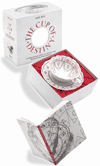
Reading tea leaves is a tradition of many kitchen witches, old aunts and kooky grandmothers. With The Cup of Destiny author Jane Lyle attempts to teach her readers a skill which tea bags and coffee makers have nearly made obsolete. This divinatory technique is meant to be a relaxing extension of staring into a cup of tea or coffee.
At the beginning of the book Lyle says she will describe two techniques which should not be combined: a “game” methodology and a “real” divinatory technique. Throughout, she offers clear and rigid directions on how to get divinatory messages. She has step by step directions outlined which are clear and easy to understand. Yet she skims over and is repetitive when describing the “game” method.
The cup and saucer are very busy with pictures covering most of the surface, but the significance of these pictures is never really explained. In four pages she discusses these symbols, yet gives only one line to play her “Cup of Destiny” game. While the author does give definitions of the symbols themselves and in a completely different section an overview of three levels for position within the cup, she doesn’t cover the significance of the symbols in relation to each other.
Throughout the book, Lyle uses clear and helpful diagrams to illustrate her techniques, but written directions were often repetitive. Literally the same information word for word is repeated in two consecutive sections, which left this reader wondering why. In the game section she utilizes the symbols on the cup to perform the divination. The reader sees where the grounds are located in the cup and instead of looking for symbols or pictures in the grounds the reader is to use the symbols on the cup. This seems to stray from the traditional tea leaf reading method.
Lyle does tell the reader to trust her own intuition over any meaning in the book. She reiterates this several times, stressing that a personal meaning is more important than her book meaning. That’s good, because some of her definitions of these symbols are clichéd and superficial. She is also inconsistent; her snake definition wavers on what it represents depending on which meaning in the book you look at.
Lyle includes astrology in tea leaf reading. Her definitions of both Eastern and Western astrological signs seem to be accurate, however, she advises the reader to only use this if they are studying these astrological techniques. At the end of the book, Lyle offers four sample readings with diagrams, which are very useful and clear. However, this section also includes information which isn’t referenced elsewhere. These both led this reader to question Lyle’s authority to discuss the topic.
While her brief definitions are interesting, Lyle contradicts some that are listed in numerous places. It seems that in an attempt to keep her format simple and short, she has left out some key chunks of information. This book might be a good starting point for someone with an interest in the topic, but if the reader is seeking depth they should go elsewhere.
2 broomsticks
~review by Eileen Troemel
Author: Jane Lyle
Connections Book Publishing, 2001
